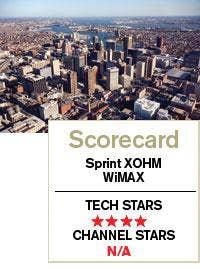Review: Baltimore Can Brag About WiMAX
Sprint held a press conference with nice food, allowed reporters to try out WiMAX connectivity on a water taxi in Baltimore's Inner Harbor, and generally made a good impression with those who checked it out on its first day. The Test Center lab is based on Long Island, so XOHM's network is still out of reach. We decided to take the lab to Baltimore following that launch to see how it really works.

What we found is a network that shows tremendous promise and a lot of 24x7 engineering over a number of years to get WiMAX even to this stage of a rollout—where it's available by one company in one city, with the rest of the U.S. looking on from a distance. Given that as recently as a year ago there were conversations throughout the IT industry questioning whether WiMAX would even make it to this point, XOHM's network shows that talk was just a lot of hot air.
WiMAX works, works nicely, and you'll be hearing more and more about it as rollouts in other metro areas take place. But it's not without pain points and it's not without the need for some significant improvements before it can replace 802.11 a/b/g as "ol' reliable" in the wireless world.
The Details Our WiMAX testing began in the morning hours on a Saturday inside the lobby of the Baltimore Hyatt Regency, using Lenovo's ThinkPad X301 with Intel's system-on-a-chip-based WiMAX/Wi-Fi Link 5350 chipset. The technology allows a system to switch back and forth between WiMAX and Wi-Fi connectivity—which will be important in what will undoubtedly be a slow migration to WiMAX (because of geographic rollout schedules).
On first pass, the Access Control Manager couldn't find any WiMAX access point and only offered up Wi-Fi—a disturbing development given the four-hour drive from New York just to test it out. Walking across the street to the outdoor area of Baltimore's beautiful Inner Harbor, a second attempt was made. Again, the ThinkPad wasn't finding any WiMAX access point—either in Windows' wireless manager or the Lenovo Access Control Manager. It was at this point a phone call went into XOHM support; they offered a recording saying they weren't yet open for business. Thanks, XOHM!
The Solution We rebooted the ThinkPad and tried again. Happily, the Access Control Manager then found XOHM's WiMAX access point and connected us right away.
Once connected, WiMAX delivered the laptop between 3 and 7 Mbps—which is about 30 times the bandwidth achieved using Wi-Fi connectivity on the same notebook. During several hours of testing, the connection to XOHM's WiMAX network never dropped once—not a single time. But using WiMAX connectivity, compared to Wi-Fi, appeared to drain the laptop's battery at about a 50 percent faster rate. Since Lenovo has been among the leaders in expanding battery life in mobile PCs for the past couple of years, it appears that the first-generation chipset may be the cause of any additional power draw.
XOHM, however, does not provide 24x7 tech support for WiMAX in Baltimore. At $50 per month per device, that's a huge problem considering it's such a new technology. As WiMAX scales out, XOHM and other providers had better be ready to have seamless tech support.
The Bottom Line There's a lot to like about WiMAX. Unlike 802.11n technology, WiMAX puts a lot of the bandwidth optimization and management into the hands of a service provider, not the solution provider. It delivers better bandwidth than the poorly adopted WLAN technology. But it's still not up to providing the low-cost, high-comfort-level connectivity of Wi-Fi. But, take heart America: Baltimore's pain could be your gain as technology and service providers learn from their mistakes and make WiMAX even better than the nice offering it is now.